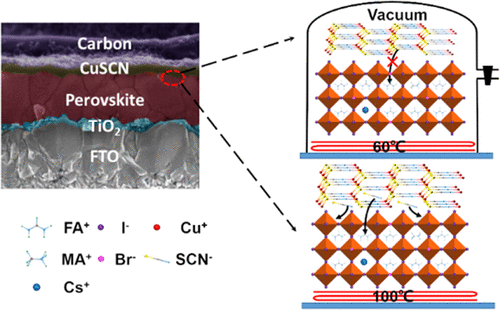当前位置:
X-MOL 学术
›
ACS Appl. Mater. Interfaces
›
论文详情
Our official English website, www.x-mol.net, welcomes your
feedback! (Note: you will need to create a separate account there.)
Vacuum-Assisted Drying Process for Screen-Printable Carbon Electrodes of Perovskite Solar Cells with Enhanced Performance Based on Cuprous Thiocyanate as a Hole Transporting Layer
ACS Applied Materials & Interfaces ( IF 8.3 ) Pub Date : 2021-05-05 , DOI: 10.1021/acsami.1c05495 Jing Wang 1, 2 , Shuiping Gong 1 , Zongqi Chen 1 , Songwang Yang 1, 2
ACS Applied Materials & Interfaces ( IF 8.3 ) Pub Date : 2021-05-05 , DOI: 10.1021/acsami.1c05495 Jing Wang 1, 2 , Shuiping Gong 1 , Zongqi Chen 1 , Songwang Yang 1, 2
Affiliation

|
Carbon-based perovskite solar cells without a hole transport layer (HTL) are considered to be highly stable and of low cost. However, the deficient interface contact and inferior hole extraction capability restrict the further improvement of the device efficiency. Introducing a hole transporting layer, such as cuprous thiocyanate (CuSCN), can enhance the hole extraction ability and improve the interface contact. However, our further studies indicated that—at a certain temperature—for carbon-based solar cells, in the CuSCN layer, the diffusion of SCN– into the perovskite film would produce more interfacial defects and aggravate nonradiative recombination, thus hindering the carrier transport. We further disclosed the reasons for performance attenuation during the thermal treatment of carbon electrodes, proposed a vacuum-assisted drying process for carbon electrodes to suppress the destructive effect, and finally, achieved an enhanced efficiency for perovskite solar cells with a CuSCN inorganic HTL and screen-printable carbon electrode. Also, the unencapsulated perovskite solar cell demonstrated over 80% efficiency retention after being stored in an ambient atmosphere (45–70% relative humidity (RH)) for over 1000 h and maintained over 85% efficiency retention for 309 h of 1-sun irradiation under a continuous nitrogen flow under open-circuit conditions.
中文翻译:

以硫氰酸亚铜为空穴传输层的钙钛矿型太阳能电池丝网印刷碳电极的真空辅助干燥工艺
没有空穴传输层(HTL)的碳基钙钛矿太阳能电池被认为是高度稳定且低成本的。然而,不足的界面接触和较差的空穴提取能力限制了器件效率的进一步提高。引入诸如硫氰酸亚铜(CuSCN)之类的空穴传输层可以增强空穴提取能力并改善界面接触。但是,我们的进一步研究表明,在一定温度下,对于碳基太阳能电池,在CuSCN层中,SCN的扩散-钙钛矿薄膜中的金属进入会产生更多的界面缺陷并加剧非辐射复合,从而阻碍了载流子的传输。我们进一步揭示了碳电极热处理过程中性能下降的原因,提出了一种用于碳电极的真空辅助干燥工艺以抑制破坏作用,最后,通过使用CuSCN无机HTL和屏蔽技术提高了钙钛矿型太阳能电池的效率。 -可印刷碳电极。同样,未封装的钙钛矿太阳能电池在环境大气(45-70%相对湿度(RH))中存储超过1000小时后,其效率保持率达到80%以上;在1次太阳照射下309小时,其效率保持率保持在85%以上。在开路条件下连续不断的氮气流下。
更新日期:2021-05-19
中文翻译:

以硫氰酸亚铜为空穴传输层的钙钛矿型太阳能电池丝网印刷碳电极的真空辅助干燥工艺
没有空穴传输层(HTL)的碳基钙钛矿太阳能电池被认为是高度稳定且低成本的。然而,不足的界面接触和较差的空穴提取能力限制了器件效率的进一步提高。引入诸如硫氰酸亚铜(CuSCN)之类的空穴传输层可以增强空穴提取能力并改善界面接触。但是,我们的进一步研究表明,在一定温度下,对于碳基太阳能电池,在CuSCN层中,SCN的扩散-钙钛矿薄膜中的金属进入会产生更多的界面缺陷并加剧非辐射复合,从而阻碍了载流子的传输。我们进一步揭示了碳电极热处理过程中性能下降的原因,提出了一种用于碳电极的真空辅助干燥工艺以抑制破坏作用,最后,通过使用CuSCN无机HTL和屏蔽技术提高了钙钛矿型太阳能电池的效率。 -可印刷碳电极。同样,未封装的钙钛矿太阳能电池在环境大气(45-70%相对湿度(RH))中存储超过1000小时后,其效率保持率达到80%以上;在1次太阳照射下309小时,其效率保持率保持在85%以上。在开路条件下连续不断的氮气流下。













































 京公网安备 11010802027423号
京公网安备 11010802027423号